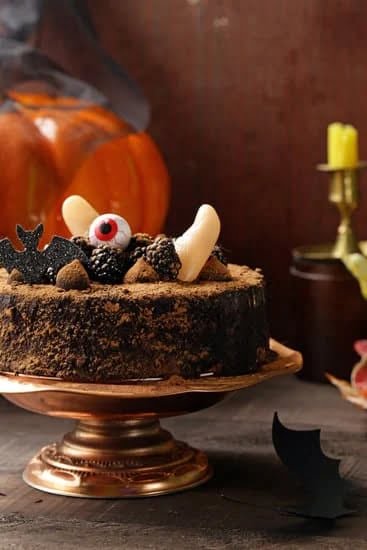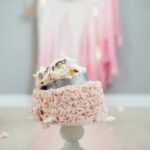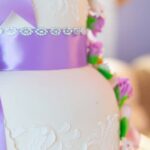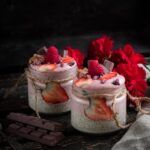Flower Design Cake Decorating is an exquisite art form that combines the beauty of flowers with the indulgence of cake. In this blog post, we will embark on a journey to understand the intricacies of this craft and learn how to create stunning floral designs that elevate any cake to a work of art.
From unleashing creativity through flower design, to mastering the basics and exploring advanced techniques, this article will provide a comprehensive guide for both beginners and experienced decorators alike.
The incorporation of floral elements in cake decorating adds depth, elegance, and visual appeal to any confectionery masterpiece. Flowers have long been associated with beauty and celebration, making them the perfect addition to elevate cake designs. Whether it’s a delicate spray of sugar flowers or simply adding fresh blooms as decoration, flower design holds a significant place in the world of cake decorating.
To begin our floral journey, this blog post will cover the importance of understanding flower design in cake decorating. We will explore how flowers stimulate visual pleasure and enhance the overall aesthetic of cakes. By understanding the significance of incorporating flowers into our designs, we can take our creativity to new heights and create show-stopping cakes that leave a lasting impression.
So whether you’re a beginner who wants to brush up on essential techniques or an experienced decorator looking for inspiration to elevate your skills, join us as we delve into the captivating world of flower design cake decorating. Get ready to be inspired by incredible examples, learn step-by-step instructions for crafting beautiful flowers, and unlock your artistic potential by embracing the beauty of flower design in your cakes.
Unleashing Creativity
Flower design plays a vital role in cake decorating, adding depth and beauty to cake designs. Incorporating floral elements into cakes stimulates the visual appeal and creates a sense of artistry. Flower design can be seen as an opportunity to unleash creativity and elevate the overall aesthetic of cake decorations.
When it comes to understanding the importance of flower design in cake decorating, it is essential to consider how it enhances the overall composition. Flowers serve as focal points or accents, drawing attention to certain areas and creating a harmonious balance. By carefully selecting flowers that complement the color palette and style of the cake, decorators can create stunning visual effects that leave a lasting impression.
In addition to aesthetics, flower design also enhances the flavor profile of cakes. Edible flowers offer not only vibrant colors but also unique flavors and textures that enhance the taste experience. For example, lavender can bring a gentle floral scent and taste, while chamomile adds a delicate sweetness. Choosing flowers with flavors that complement the cake’s ingredients can elevate its taste and make it even more memorable.
Understanding the importance of flower design in cake decorating allows decorators to unleash their creativity and experiment with different techniques. Whether it’s using fresh flowers for a natural look or creating realistic sugar flowers, there are countless possibilities for incorporating floral elements into cakes. With proper knowledge of techniques, tools, and materials, decorators can master the art of flower design and create truly stunning works of edible art.
Mastering the Basics
When it comes to flower design cake decorating, mastering the basics is essential for creating beautiful and visually appealing cakes. Whether you are a beginner or have some experience in cake decorating, it is important to establish a solid foundation before diving into more advanced techniques. This section will provide step-by-step instructions on how to get started with flower design cake decorating and explore the essential techniques, tools, and materials required for this artistic journey.
Step 1: Gathering Essential Tools and Materials
Before starting your flower design cake decorating project, it is crucial to gather all the necessary tools and materials. These may include:
- Piping bags and tips: Invest in a set of quality piping bags and various sizes of tips to achieve different flower designs.
- Flower nail: A flower nail is a small tool that helps create flowers with precision and control.
- Flower foam pad: This pad provides a soft surface for shaping petals and leaves.
- Gel or paste food coloring: Use gel or paste food coloring as they do not change the consistency of your icing.
- Flower cutters: These come in various shapes and sizes to create different types of flowers.
Step 2: Understanding Icing Consistencies
Icing consistency plays a crucial role in achieving the desired flower designs. There are three main consistencies you need to familiarize yourself with:
- Stiff consistency: This type of icing holds its shape well and is perfect for creating intricate details like ruffles and swags.
- Medium consistency: Used for piping flower petals that maintain their shape but can slightly spread.
- Soft consistency: Ideal for filling in larger areas, such as covering the cake or creating smooth borders.
Step 3: Practicing Basic Flower Designs
Start by practicing basic flower designs using buttercream or royal icing. Some beginner-friendly flower designs include simple roses, daisies, and tulips. To create these flowers, you will need to learn basic piping techniques such as:
- Pipe a small dot in the center for the bud.
- For roses, pipe an initial spiral motion for the center and add petals around it.
- Daisies can be created by piping a circle of petals around a central dot.
By mastering these basic flower designs, you will gain confidence and a solid foundation for creating more intricate floral decorations on your cakes.
Getting started with flower design cake decorating is an exciting journey that allows you to unleash your creativity and add beauty to your edible creations. By following these steps and practicing regularly, you can develop essential skills and techniques necessary for creating stunning flower designs on your cakes. So let’s gather our tools, understand icing consistencies, and start honing our skills to elevate our cake decorating game.
Blooming with Flavors
Choosing the Perfect Edible Flowers for Your Cake Design
When it comes to creating a visually stunning and delicious flower design cake, selecting the perfect flowers is key. Edible flowers not only add a pop of color and beauty to your cake but also contribute unique flavors and textures that can elevate your baking experience. In this section, we will explore the different options for edible flowers and discuss how to choose the perfect blooms for your cake design.
Exploring Various Edible Flowers
There is a wide variety of edible flowers to choose from when it comes to decorating your cake. Roses, lavender, pansies, marigolds, violets, and chamomile are just a few examples of popular edible flowers that can be used in cake decorating. Each flower offers its own distinct flavors and characteristics.
Considering Flavor Profiles and Color Palettes
When selecting edible flowers for your cake design, it’s important to consider both flavor profiles and color palettes. Some flowers may have a more subtle taste that complements the overall flavor of the cake, while others may have a more pronounced or even spicy flavor. It’s important to experiment with different combinations to find the perfect balance.
Additionally, consider the color palette of your cake design. Choose flowers that will complement or contrast with the colors already present in your cake. For example, if you have a pastel-colored cake, vibrant flowers like pansies or marigolds can create stunning visual appeal.
Safety Considerations
While many flowers are indeed edible, it is crucial to ensure that the specific variety you choose is safe for consumption. Avoid using flowers that have been sprayed with pesticides or other chemicals. When in doubt, it’s best to consult with a knowledgeable florist or horticulturist who can guide you in choosing safe and flavorful blooms.
Remember that some people may have allergies or sensitivities to certain flowers, so it’s important to inform your guests about the edible flowers used in your cake design.
By carefully selecting the perfect edible flowers for your cake, you can not only create a visually striking masterpiece but also delight your taste buds with unique and delicious flavors. Experiment with different combinations, seek inspiration from nature, and let your creativity bloom in the world of flower design cake decorating.
Petal Power
One of the most captivating aspects of cake decorating is the ability to elevate the overall design by skillfully arranging flowers. Flower arrangements on cakes can add a sense of elegance, whimsy, or even drama, depending on the chosen arrangement technique. In this section, we will explore different flower arrangement techniques and provide tips on achieving visual balance and harmony through skillful placement of floral decorations.
When it comes to flower arrangements on cakes, there are several techniques that can be employed to achieve a desired effect. One popular technique is cascading, where flowers flow gracefully down the side of the cake in a trailing manner. This technique works well for creating a dramatic look and adding movement to the design. By choosing flowers with varying lengths and sizes, you can create a visually striking cascading effect.
Another technique is clustered arrangement, where flowers are grouped together in clusters or bouquets on different parts of the cake. This technique is great for creating focal points and adding texture to the design. By using different types of flowers and incorporating foliage or other decorative elements, you can create beautiful and eye-catching clusters that enhance the overall appeal of the cake.
For those who prefer a more subtle approach, scattered flower arrangements offer a delicate and whimsical touch. With this technique, small flowers are scattered throughout the design to create an ethereal effect. It’s important to choose flowers that are proportionate to the size of the cake and ensure that they are evenly distributed for a balanced look.
To achieve visual balance and harmony in flower arrangements on cakes, it’s essential to consider factors such as color choice and placement. A well-balanced arrangement should have a mix of colors that complement each other and blend harmoniously with the rest of the cake’s design. Additionally, consider placing larger or more vibrant flowers as focal points while filling in gaps or empty spaces with smaller blooms or foliage.
Making Life-like Blooms
Enhancing a cake with realistic flower designs can elevate its visual appeal and create a stunning centerpiece for any occasion. By mastering the art of creating life-like blooms, cake decorators can take their skills to the next level and captivate their audience with intricate floral decorations. This section will provide detailed instructions on shaping and coloring various sugar flowers, as well as introduce innovative tools or molds that can enhance the realism of flower designs.
To create realistic sugar flowers, it is essential to pay attention to details and mimic the textures and shapes found in nature. For example, crafting roses requires carefully shaping individual petals and layering them together to form the iconic bloom.
Orchids can be achieved by cutting out individual petal shapes from gum paste or fondant and attaching them together in a natural arrangement. Meanwhile, daisies can be crafted by using a combination of cutters and veining tools to add depth and dimension.
Coloring plays a vital role in bringing realism to sugar flowers. Just like blossoms found in nature, sugar flowers should have variations in color tones and shades. Edible dusts or petal dusts are often used to achieve this effect. These powders can be applied gently with a small brush to create subtle shading or vibrant accents. Additionally, adding edible glitters or glosses can give flowers a fresh dewy appearance.
Mastering the techniques of creating life-like blooms requires practice and experimentation. Cake decorators may find it helpful to invest in specific tools or molds designed for creating realistic flower designs. Veiners, for instance, are used to add texture by imitating the veins on petals or leaves. Silicone molds of natural flower shapes can also speed up production while maintaining accuracy.
To summarize, creating realistic flower designs for cakes requires attention to detail and skillful shaping and coloring techniques. By honing these skills and using specialized tools or molds, cake decorators can achieve stunning floral decorations that bring charm and elegance to their creations. The next section will further expand on advanced techniques in flower design cake decorating, allowing decorators to take their skills even further.
Taking It to the Next Level
Taking your flower design cake decorating skills to the next level requires incorporating advanced techniques that can truly elevate the overall design of your cakes. These techniques allow you to showcase your creativity and attention to detail, resulting in awe-inspiring floral creations. Here are some advanced techniques that you can explore:
- Stringwork: Stringwork involves delicately piping intricate lines or strings onto a cake, creating a web-like effect. This technique requires steady hands and patience as it involves piping thin strings of royal icing or buttercream onto the cake. Stringwork can be used to create beautiful latticework or to add delicate borders and accents.
- Over-piping: Over-piping is a technique that involves layering piped designs on top of each other to create depth and texture. It allows you to add intricate details and embellishments to your flower designs, making them visually stunning. Over-piping can be used for creating intricate lace effects, adding dimension to petals, or even creating the illusion of movement in floral arrangements.
- Bas-relief: Bas-relief is a sculptural technique where designs are raised from a flat surface while remaining attached to it. In cake decorating, bas-relief can be achieved by carving out the desired design on a cake and then covering it with fondant or gum paste. This technique creates stunning three-dimensional effects and allows for intricate detailing on flowers and other elements.
To incorporate these advanced techniques effectively, it is important to practice and gradually build your skillset. Additionally, utilizing specialized tools such as fine-tipped piping nozzles, silicone molds for detailed flower shapes, and embossing tools for texture can enhance the intricacy of your designs.
Remember that experimentation is key when incorporating advanced techniques into your flower design cake decorating process. Don’t be afraid to push boundaries, try new things, and let your creativity shine through. With time and practice, you’ll be able to achieve truly remarkable floral creations that will leave your guests in awe.
Tying It All Together
One of the most exciting aspects of flower design cake decorating is the opportunity to showcase your creativity and create stunning works of art. In this section, we will explore some inspiring examples of flower design cake decorating that will leave you in awe and fuel your own creative imagination.
A Feast for the Eyes: Exquisite Floral Cake Masterpieces
Cake artists around the world have truly embraced the beauty of flower design in their creations. Whether it’s a simple buttercream cake adorned with delicate sugar blossoms or an elaborate fondant masterpiece featuring an array of realistic handmade flowers, these cakes are guaranteed to impress.
Imagine a three-tiered wedding cake covered in intricately piped flowers cascading down each tier or a whimsical birthday cake with a charming garden scene made entirely out of edible blooms. The possibilities are endless when it comes to incorporating flower designs into cake decorating.
From Traditional to Contemporary: Flower Designs for Every Occasion
Flower design cake decorating offers versatility that allows you to tailor your creations to any occasion. For weddings, elegant and romantic floral arrangements take center stage, incorporating classic blooms like peonies, roses, and hydrangeas. On the other hand, modern and minimalist cakes often feature bold and unconventional flower choices such as proteas or succulents. Birthdays can be celebrated with vibrant and playful designs using colorful buttercream flowers or fondant decorations shaped like daisies or sunflowers.
The Artistry of Edible Botanicals: Showcasing Nature’s Bounty
The beauty of flower design cake decorating lies not only in its visual appeal but also in its celebration of nature’s bounty. Many talented cake artists utilize fresh edible flowers like lavender, pansies, or violets as creative elements on their cakes.
These organic decorations not only enhance the aesthetic appeal but also add unique flavors and textures to complement the overall taste experience. From delicate and subtle floral notes to vibrant bursts of flavor, incorporating edible flowers into your designs can take your cake decorating to the next level.
Conclusion
In conclusion, flower design cake decorating is a captivating art form that adds depth and beauty to cake designs. By incorporating floral elements, cakes become visually appealing and evoke a sense of elegance and celebration. Throughout this blog post, we have explored the importance of flower design in stimulating the visual appeal of cakes and discussed various techniques, tools, and materials required to get started with this artistic journey.
One crucial aspect of flower design cake decorating is the selection of flowers that complement the overall design of the cake. Edible flowers offer not only vibrant colors but also unique flavors and textures that can enhance the taste experience. It is essential to ensure that the flowers chosen are safe for consumption in cake decorating.
Additionally, skillful flower arrangement techniques play a significant role in elevating cake decor. Whether it be cascading, clustered or scattered arrangements, achieving visual balance and harmony through thoughtful placement of floral decorations creates an exquisite centerpiece. Furthermore, mastering the art of creating realistic sugar flowers amplifies the beauty and authenticity of cake designs.
For those seeking to take their skills to another level, advanced techniques such as stringwork or bas-relief can transform cakes into awe-inspiring masterpieces. The incorporation of these techniques allows for intricate designs that leave a lasting impression on those who admire them.
Finally, we encourage you to explore the world of flower design cake decorating and unleash your creativity. By embracing this art form, you not only create stunning edible works of art but also bring joy and delight to those who indulge in your creations. So grab your tools, experiment with different techniques, explore new flavors through edible flowers, and let your imagination bloom as you embark on this beautiful journey of floral cake decoration.

Welcome to our cake decorating blog! My name is Destiny Flores, and I am the proud owner of a cake decorating business named Cake Karma. Our mission is to provide delicious, beautiful cakes for all occasions. We specialize in creating custom cakes that are tailored specifically to each customer’s individual needs and tastes.





